1867: Tuahiwi
October 21, 2022
By AHNZ
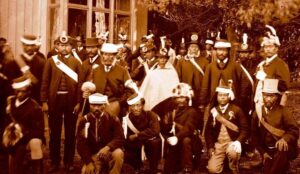
The remains of the Ngai Tahu tribesmen in Canterbury made a great alliance in 1848 with the Kemp Deed though it came much too late to avoid their destruction. The natives had been beaten and scattered by the Ngati Toa invasion at the hands of Chief Te Rauparaha (See 1830: Slaughter by Surprise) and only turned back the invaders’ advance years later in faraway Southland (See 1836: Battle of Tuturau.) Weak from their own Civil War, the Ngai Tahu were no match for Rauparaha’s Empire which commanded vast armed resources powered by several whaling stations he controlled in the palm of his hands.
Ngai Tahu were still afraid when Kemp came and some of their enslaved people had only recently (1839) been released from captivity. Te Rauparaha’s conquest of the Ngai Tahu was no less than what they themselves had done at an earlier date to the prior ‘manawhenua’ tribes before them. With Kemp’s Deed the remaining Ngai Tahu would be protected by the new Colonial Government and could once again venture out into the middle South Island from coast to coast. The majority of this land they sold but reserved for themselves a rich and fertile area near their old broken battlefield that was Kaiapohia (Ref. 1832: Kaiapoi vs Kaiapohia.)
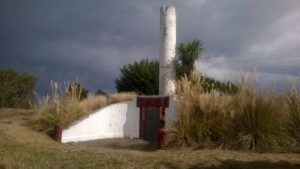 Ngati Tahu were initially reluctant to use the Kaiapoi Maori Reserve, preferring to keep in close to the safety and economy of the whaling stations and new settlers. There were only between 100 and 250 of them surviving after the massacres but this number was swelled by a further 250 after the captive slaves were returned (1839.) According to Hight and C.R. Straubel (1957) the 1851 census found 37 Maoris at Port Levy, 106 at Little River and Taumutu, and just 104 living between the Waimakariri and Ashley rivers. They called their Reserve ‘Tuahiwi’ and considered it and the ruins at Kaiapohia taboo and unsafe. They probably considered Rauparaha still had the spiritual power (manawhenua) over the land once theirs after he had sacked it. One of Rauparaha’s early acts was to exhume a young Ngai Tahu woman’s body buried in a canoe and to cook and eat it as a rite of domination. The Canterbury Settlers’ leadership, Robert Godley and Rev. James Stack in particular, emboldened and encouraged the Maoris to reclaim their old home. It took a while for them to accept that the new white man’s magic was strong enough to counteract Rauparaha’s taboos and slaughter.
Ngati Tahu were initially reluctant to use the Kaiapoi Maori Reserve, preferring to keep in close to the safety and economy of the whaling stations and new settlers. There were only between 100 and 250 of them surviving after the massacres but this number was swelled by a further 250 after the captive slaves were returned (1839.) According to Hight and C.R. Straubel (1957) the 1851 census found 37 Maoris at Port Levy, 106 at Little River and Taumutu, and just 104 living between the Waimakariri and Ashley rivers. They called their Reserve ‘Tuahiwi’ and considered it and the ruins at Kaiapohia taboo and unsafe. They probably considered Rauparaha still had the spiritual power (manawhenua) over the land once theirs after he had sacked it. One of Rauparaha’s early acts was to exhume a young Ngai Tahu woman’s body buried in a canoe and to cook and eat it as a rite of domination. The Canterbury Settlers’ leadership, Robert Godley and Rev. James Stack in particular, emboldened and encouraged the Maoris to reclaim their old home. It took a while for them to accept that the new white man’s magic was strong enough to counteract Rauparaha’s taboos and slaughter.
“It is said that Te Rauparaha’s party found the body of a young Ngai-Tahu woman buried in a small canoe here. This was a common burial custom. The raiders cooked and ate the body by way of insult to the local Maoris.” – The New Zealand Guide (1957)
“The return of the Ngai Tahu to Kaiapoi took place in 1850-1, but although the reserve marked out at Tuahiwi by Mantell in 1848 was available to them from that date onwards they displayed a reluctance to use it. After the fall of Kaiapohia, Te Rauparaha had destroyed Tuahiwi and several small kaiangas near by, with the result that the Ngai-Tabu considered Tuahiwi, like the old pa, to be sacred.” – p44, Hawkins (1957)
“We left Tuahiwi because it became sacred…It was fear of the deities that made us remove from Tuahiwi to Tioriori….We were induced to locate ourselves again at Tuahiwi by the Rev. J. W. Stack.” – Wiremu Te Uki of Tuahiwi, Smith-Nairn Commission (1879); Taylor (1952)
By the early 1850s the Nagai Tahu of the middle-South Island had a home again. Along with the land they had been attributed these few natives were also made rich men by the thousands of pounds paid to them for selling it as well as large reserves of land rich in timber, fish, game, and fertile soil. This was an incredible gift and reversal of fortunes, especially for the majority who had been enslaved not a decade before. It was also an introduction into civilisation and the law to a people who named their sub-tribe Ngai Tuahuriri after the father of the conquering brothers Turakautahi and Moki who originally invaded and slaughtered those who held these lands before them. The Settlers could have easily done the same but instead offered a new culture and the opportunity to thrive as never before.
Stack’s Mission of the 1860s

On 9 February, 1867, Governor George Grey was given a great welcome on his visit to the Native Reserve (Tuahiwi.) His visit was an affirmation of official contact and local prosperity for the Maori colony that had been growing and prospering alongside the Anglo Settlers who had started out at the same time (1850.) The wealthy Maoris had invested in cattle but lost nearly all of them to disease that had also been a blow to the Canterbury Pilgrims. On the other hand, their crops sometimes did better¹. Grey was welcomed by throngs of happy, healthy, well-dressed natives to their village. His cortege passed through 3 archways as loyal subjects lining the way demonstrated whose side of the Maori Wars in the north they were on: His!
“..a handsome and more pretentious arch of evergreens, flowers, and flags had been erected, and along each side of the road for some distance the Maoris were arranged in files, the men on the right side and the women on the left…a lusty hurrah was given by the whole of those assembled.”
“The whole of the Natives, it may be well to remark, were dressed in full English costume from top to toe, and certainly the men, many of them with their “bell toppers” and good black coats, as well as the ladies with their scarlet jackets, white round-about hats, and silk dresses with, in some instances, a profusion of costly jewelry displayed, bore a very good comparison to their neighbours, from whom their examples had been borrowed.” – Sir George Grey’s Visit to the Kaiapoi Natives, Press (1867); Papers Past
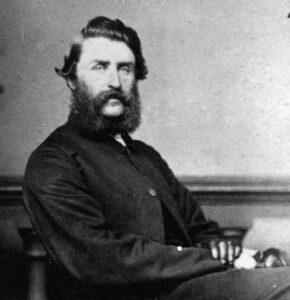 Grey lay the foundation stone for a new church with a message in a bottle beneath that is probably still there to this day. This was the new St Stephen’s Church (image, left) named as the sister church to the one in Parnell, Auckland, where the Tuahiwi missionaries Mr James Stack and his wife Mary had been married. Stack had come at the personal request of Bishop of Christchurch Henry Harper to lead the “first” Maori Mission in the South Island. The couple came in 1859 and battled away to improve the condition of the native’s education, prosperity, and souls for the full measure of a decade.
Grey lay the foundation stone for a new church with a message in a bottle beneath that is probably still there to this day. This was the new St Stephen’s Church (image, left) named as the sister church to the one in Parnell, Auckland, where the Tuahiwi missionaries Mr James Stack and his wife Mary had been married. Stack had come at the personal request of Bishop of Christchurch Henry Harper to lead the “first” Maori Mission in the South Island. The couple came in 1859 and battled away to improve the condition of the native’s education, prosperity, and souls for the full measure of a decade.
Ultimately the Stacks gave up in disappointment because the Maoris regressed into communism and indolence, refusing to work their land. Tuahiwi became a real life Animal Farm (Ref. George Orwell, 1945) as the idle were supported by the industrious until there was no point any longer in being industrious. The Maoris leased out their land for Anglos to farm for them, taking the rent money. School attendance became poor. Giving up their old farming homes the natives gave themselves poorer housing which led to illness and death. After the Stacks’ house burned down and the school too, in 1870, he withdrew in defeat. The Maoris drifted further into poverty and instead became disciples of a new prophet named Walter Mantell who taught them how to make a living by grievance and compensation. From 1872 to 1998 the tribe has received a “full and final” settlement no less than 4 times each time the money from the previous one ran out! Ref. 1998: Ngai Tahu Claims Settlement Act, AHNZ
The Native Reserve remains the main center of the Ngai Tahu tribe. After George Grey it has warmly greeted many Prime Minister and Governors General. For example, William Rolleston, John Ballance, Richard Seddon, James Carroll, Apirana Ngata, George Forbes, Michael J. Savage, Norman Kirk, and probably many more. Only one visit has not been welcomed warmly. When Prime Minister Jacinda Ardern tried to visit in February 2022 to try to sell her ‘free lunch’ program she was vigorously protested upon by locals disbelieving of her pandemic controls. Ref. Protesters chase Ardern’s vehicle down driveway after school visit, TVNZ (2022)
Tall Tales of Tuahiwi

In October 2022 a very different account of the history of the Maori Reserve was given. Antony Nihoniho, University of Canterbury Lecturer in Māori & Indigenous Studies and Trainer in Biculturalism spoke to a group as part of his well-funded scholarship to become a doctor in this specialist subject. It’s an insight into who gets scholarships and titles and what version of history they need to tell in order to get it. Hint: Not the sort you read at AHNZ!
This will be a secondary source as Nihonio’s thesis has yet to be published. We have Ruth Gardner’s account of the talk published at Ruth’s Reflections. Ruth (image, left) would, given her affiliations, probably be chased out of Tuahiwi alongside Jacinda Ardern if she were to visit with her convictions on her chest! But thanks all the same for your thoughtful recording of Antony’s speech. The following are some highlights…
“They saw land as not able to be owned, but rather conferring responsibilities, and giving the right to resources.”
Same slogan I hear on the safety briefing on Air New Zealand flights at the moment for publicity purposes. Generally an attempt to align the brand with the current political fashion which in this case is environmentalism. In this case it’s also setting up an excuse for why Ngai Tahu needed more money and property top-ups for 170+ years on the basis of not understanding what money and property were.
“In England in the 18th and 19th centuries there had been a change from feudalism to capitalism…land previously held in common and many rural people became paupers. After their land was no longer available the only thing they had left to sell was their labour.”
Nihoniho is setting up the English Settlers as perpetrating some kind conspiracy against Communism against Maoris that had been successfully exploited onto themselves. This is an ahistorical statement. A thin disguise of far-left thinking.
Feudal peasants were not “rural people” they were surfs who would have told anyone who asked that the land (“their land”) belonged not to themselves in common but to the King or their Lord.
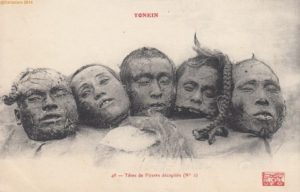 “Kāi Tahu had moved to Te Wai Pounamu/ the South Island and absorbed the tribes of Waitaha and Ngāti Māmoe.”
“Kāi Tahu had moved to Te Wai Pounamu/ the South Island and absorbed the tribes of Waitaha and Ngāti Māmoe.”
Nihoniho is unwittingly (or worse, knowingly,) minimising what Ngai Tahu did to the Mamoe. They did not simply “absorb” them but chopped off their heads and then carried them in baskets to the top of Mt Cavendish as an offering to their war god. The sacred places and the lands of the previous tribe were desecrated in the same or a similar way to what Te Rauparaha did to themselves later. Ref. 1700: The First Christchurch Gondola, AHNZ
Antony is setting up his superstructure with Europeans as odd-balls with quaint ideas about property. Meanwhile, the enlightened noble savage caretaker of mother earth “absorbs” new people into their community peacefully in contrast to the brutal transactions of Kemp’s Deed! This is ridiculous.
“The Kāi Tahu economy thrived, and included international trade.”
For a little fib you can make Ngai Tahu sound internationally impressive. But the credit for being international goes to the Western whaling fleets that sailed the oceans not the few Maoris who met them at the beach and traded shrunken heads for iron nails.
“In 1829-32 Te Rauparaha sacked the Kaiapoi Pā. At the same time Māori were affected by measles, influenza, and tuberculosis pandemics, introduced by immigrants.”
This statement makes it sound as if Ango Settlers had weakened Ngai Tahu with sickness leading to their defeat. Yet Rauparaha is the one with the most contact with the West so if anyone should be affected by disease it would be his invasion force not the home team. I am aware of no immigrants in 1829 or earlier who brought sickness to these Maoris. That came later, and much further south in the mid-1830s. I hope our PhD hopeful isn’t simply making this story up to shore up his case. Ref. 1830s: Measley Beach, AHNZ
“Kemp Deed of 1848,..It was promised …that schools and hospitals would be provided.”
Schools certainly were provided right away. Henry Fletcher was there in 1851 and worked at it for 2 or 3 years. The Maoris did not want to learn. When Stack built a new school in 1863 it went unused for 2 years until just one pupil turned up. The Maoris did not like to pay for a teacher and considered the teacher should be paying them! Nor would the Maoris respond to the offers of medical help as we have seen from James Pope’s work in the next generation. Ref. 1884: Health For The Maori, AHNZ
As an aside, The State did built a full hospital in New Plymouth still standing today called The Gables. In a tourist pamphlet it was described in terms of an attempt to “colonise” the natives by inflicting Western medicine upon them! Build hospitals, don’t build hospitals, you get attacked either way.
“…with no schools or hospitals, the British expectation being that the tribe would soon die out.”
This phrase makes Maori extinction sound like a political policy solution. Big pause for the audience to gasp after that one! In fact the Maoris themselves were the ones predicting their own demise as well as causing it. Ref. 1892: The Past and Future of the Maori, AHNZ
“..they pleaded for land to be allocated so they could participate in the growing economy.”
Maoris in our own era also successfully campaigned for rights to radio and television airwaves as part of their grievance settlements despite there being no such thing when the deal was made. Nor, in 1848, did anyone anticipate the new extensive farming model of the ‘growing economy’ of the 1850s. The Maoris were given what they agreed to, what everyone else got, and a huge store of cash besides. The resources were there for them to continue in their contemporary means of production: hunting, gathering, and raising Western vegetables. When Canterbury discovered sheep were the way to go the Settlers had to think fast on their feet and adapt. Well, if Maoris wanted in on this new economy so would they. Instead, they complained at not being allocated sheep stations before there were sheep. May as well complain about not having wifi before computers are invented.
“The tribe descended into abject poverty with children dying, and people living in squalor unable to feed their families…Canterbury Provincial Council was established. Swamps and wetlands were drained. Pastoral farming was imposed and boomed, but Kāi Tahu were unable to participate”
This occurred after Stack’s Mission of the 1860s and as a result of their turning to the Dark Side of Mantell’s Victimhood Culture ethics. Stack was desperate for his Maoris to continue farming but instead they cashed-in and leased their land to Settlers like Joseph Moody who improved the land and earned the profit.
“By 1865 572 farms had been established by settlers north of the Waimakariri. Kāi Tahu were unable to vote or stand for local body elections,..”
This is because they had self-government, as they wished. Insisting on what Peter Buck called the Maori Communistic System (Ref. AHNZ.) Maoris were granted full British citizenship by the efforts of James FitzGerald when Native Minister in 1865. Maoris didn’t live in New Zealand to begin with at all but kept to their own country within a country, only migrating in the 1960s. Participation was their own choice. Ref. 1960s: The Second Great Migration, AHNZ
” e.g. for…Agricultural and Pastoral Associations.”
Where is the speaker getting this stuff? Chief Pita te Hori was not only welcomed at but won a prize at the very first Northern A&P Show. What’s the problem that this isn’t enough? Were there supposed to be unelected iwi representatives and Maori Wards in the 1860s? Affirmative Action for Maoris hadn’t even been invented back then. Ref. 1866: Northern Agricultural and Pastoral Association, AHNZ.
“Lawyers were allowed to represent both the Māori owners and the Pākehā purchasers, and sometimes bought land themselves.”
Implication here that lawyers may not own property and that they cannot be trusted with their client’s work due to conflict of interest. Also, again, the cry for lawyers to be “allowed” or “disallowed” by some higher power (The State) since Maoris apparently lack agency to select their own legal services.
“In 1966 Rangiora County Council decreed that only one house was allowed on each ten acres, (remember, Māori whanau had only 14 acres each), and this was not changed until 2011. Tuahiwi was not provided with water-lines, sewerage, footpaths, or other amenities.”
In 1966, as now, the people of Rangiora want to protect their productive land. People with a ‘Townie’ mindset like Antony Nihoniho forget that farmers use sunlight, rain, and their soil to be the primary producers that are the backbone of New Zealand’s economy. It’s what pays for their university scholarships and electric cars and the mostly cosmetic lifestyle consumer goods taken up by 90% of any shopping mall. By paving over the land with concrete subdivisions and urbanisation we are cutting our own throats which was a fact 1960s local government was quite exercised by.
Demanding Maori exceptionalism for Tuahiwi is what this was in the 1960s as well as when Nihoniho brings it up out of context. He’s make out as if some targeted evil is being done to the Tuahiwi community to stop them from being close to their families when really it was a rule by the people for all the people. Note also that it’s a flip-flop from earlier when he was complaining families didn’t get enough space but here we are now complaining that they cannot reduce their existing space by even further concentration!
As for sewers, footpaths, and water-lines, well! Even today there are many rural settings that don’t have these things. We have our own well water, septic tanks, and we walk on the grass verge to get to our schools. Only Townies who grow up with infrastructure surrounding them in 3D would find this to be alienating or some sort of deliberate impoverishment.
“Antony spoke of his paternal grandmother, Te Uira Barrett (1907-79) who had been a significant landowner and should have had a prosperous life.”
Well, did grandma work her farm or did she collect the rents and blow it on tobacco? Keen to learn more.
“In 1937 there was a Māori Housing Survey…with patronising comments judging whether some Māori were able to live “like Europeans”.”
State damned if it doesn’t help and damned if it does. And, note, we’re at the level of criticising 1930s documents for not being Politically Correct to 2020s standards. I recently learned a new term for this fallacy: Presentism. It’s rampant.
“Kāi Tahu are no longer invisible, and today are involved in assisting the Christchurch City Council..”
Paid roles in bi-cultural safety and non-elected spots in local government affairs. ‘Assisting’.
“The story told of Tuahiwi applies also to other Kiwi”
‘Kiwis,’ plural. Yes it does.
“He spoke of how all parties involved had been trying to operate out of the best interests of their family, and considered how we can prevent such a disaster happening again. One way is to make the partnership between our two peoples work.”
As Bishop of Christchurch William Pyatt said at Tuahiwi on the centenary of George Grey’s visit, “We can’t be separate any more. We are one country and we must go on together.” Perhaps a better way to prevent disasters is to have one standard of citizenship. We don’t need partnership if we are all one people as Governor William Hobson is quoted as having said to each chief as he signed the Treaty of Waitangi. Yet clearly this Maori exceptionalism and historical grievance is very much part of what Mr Nihonio seeks to embed in his thesis and in the minds of his future university students.
—
1 Lore and History of the South Island Maori, William Taylor (1952)
Image ref. Maoris at Kaiapoi, Dr A C Barker Collection, Canterbury Museum
Image ref. Kaiapohia ruins; AHNZ files (2015)
Image ref. St Stephen’s Church, Kaiapoi Maori Reserve; AHNZ files (2015)
Image ref. James Stack, Alexander Turnbull Library
Image ref. Ruth Gardner with PSA halos, Facebook (2021)
Ref. Beyond the Waimakariri, Don Hawkins (1957)
Ref. A History of Canterbury by James Hight and C.R. Straubel (1957)
Ref. Centenary Of Tuahiwi Church Celebrated, Press (1967); Papers Past
6 thoughts on "1867: Tuahiwi"
Leave a Reply
 Like Comment Share
Like Comment Share

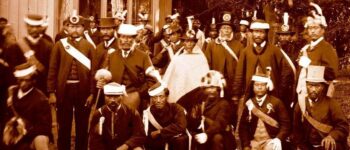




That was another fascinating read from your blog, which filled a significant gap in my knowledge. It’s not hard to guess which version – yours or Mr Nihoniho’s – of this local history will make it into the new NZ history curriculum.
Thanks. No scholarships for me. Maybe I can sell AHNZ coffee mugs on Trade Me for book money?
So long as there are people to read it I’ll keep publishing my findings. Much appreciated.
You’ve got this very very wrong. The council gave other villages urban settings so people could build, but Tuahiwi was not afforded this same privilege despite the fact many Māori lived there. Furthermore, the natives were highly amenable to having their own subdivided sections and blocks. Despite revisionist scholarship, Māori understood property rights. Happy to send you resources proving this. The problem was that 14 acre blocks are not enough to properly farm- refer to the fact that the sustenance level for Europeans at the time these reserves were handed out was 50 acres. Furthermore schools and hospitals were not provided at the level promised. I could go on and on, this is insultingly poor scholarship
Thanks for commenting. Disagreement welcome. This area is my home and growing up we never had water piped in or sewage piped out or footpaths. Still don’t. When I lived in Loburn I found it weird to have this new-fangled thing, a community water supply. Expecting Tuahiwi to have those things is Maori Exceptionalism.
“Furthermore, the natives were highly amenable to having their own subdivided sections and blocks.”
So were lots of Canterbury farmers because it’s a great way to liquidate and cash out. The community authority said no for reasons given above. Tuahiwi Maoris in the 1970s kicked up a stink under the guise of luring the Boomer Maoris back from the city (as if they could reverse this nation-wide generational migration!) Again, special pleading of Maori exceptionalism.
“The problem was that 14 acre blocks are not enough to properly farm- refer to the fact that the sustenance level for Europeans at the time these reserves were handed out was 50 acres.”
I’d like to see your evidence for that. In 1848 neither these Maori Settlers nor the Anglo knew they needed 50. They were still under the Wakefield plan until at least 1850 and distributed land accordingly. Nobody thought each Maori needed to be given enough land to rival Erewell, Mt Grey, or Glenmark stations. They gave them land to support the lifestyle they had which was hunter-gatherer. Plus tall piles of money, rich land, and forestry, to advance if they would.
“Furthermore schools and hospitals were not provided at the level promised.”
I’m content for now that we’ve gone from ‘not provided at all’ to ‘not provided at X level’ and call that a win.
“I could go on and on, this is insultingly poor scholarship”
Ah, so it’s another Maori scholarship academic guy. You should apologise and make your case and then, if you’re right, you can employ shaming if that’s how you roll. It’s premature for you to declare victory here. Besides, I like being wrong about things so bring it on.
1858 Stat’s
Interesting that the census of 1857/8 only found 1314 Males and 905 females, giving a miniscule Maori population in the South Island (middle) of 2219
I also note that Ngati Toa got $10million out of $70.61million redress for loss of trading slaves and skulls in upper South because of white man insisting on Laws. Ngati Toa redress
Ngati Toa redress